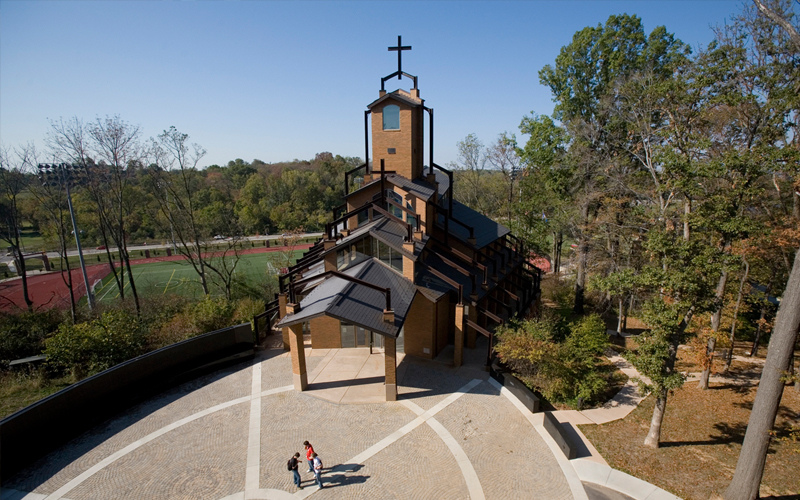
Nestled on a hill in the woods, Our Lady of the Woods Chapel is a place of worship and a work of art in its own right.
A masterpiece of glass, wood, and steel, the chapel stands in memory of John A. Floersh, who was the Archbishop of Louisville when he founded Bellarmine as a local Catholic college for men in 1950. Today the chapel serves both men and women of the University, and students of all faith traditions.
Former Bellarmine President Alfred Horrigan and former Bellarmine President Joseph J. McGowan carefully selected the wooded site, which was approved by a committee of faculty and students.
The chapel was dedicated on May 11, 2001, as a place of worship for Bellarmine students. The community celebrates Mass in the chapel on Sundays and holy days, and uses the chapel for retreats and interfaith services.
In the chapel's vestibule, you'll find reliefs of the founder of the university, Archbishop John A. Floersh, and the University's patron, Saint Robert Bellarmine. Some history about these men is helpful: Among other outstanding qualities, Archbishop Floersh was known for his astute real-estate sense. Possessed of three pastoral hills in Louisville's beautiful Highlands neighborhood in 1949, he instructed Father (later Monsignor) Alfred Horrigan to found a men's college on this site.
At the time, Horrigan and his fellow priests made their retreats at a Jesuit retreat center in Indiana whose chapel was named for Saint Robert Bellarmine, a Jesuit apologist of the 15th and 16th centuries. They chose Bellarmine as the patron saint of the college. Although Bellarmine University is named for a Jesuit, it is an independent Catholic university that has never been a Jesuit institution.
The renderings of Archbishop Floersh and St. Robert Bellarmine in Our Lady of the Woods' vestibule are by retired University art professor Bob Lockhart.
Lockhart also created the Holy Family in the prayer space behind the altar. (In addition to the statues in the chapel and the Angela Merici statue, Bob Lockhart also made the beloved Knight between Horrigan Hall and the Brown Library.) Note that Lockhart depicted Jesus as an adolescent and not as a baby, in order to more closely align him to the age and circumstances of Bellarmine students. Also notice that Joseph has his arm around Mary in a rather non-traditional show of affection, emphasizing the blessing of family. On Joseph's right hand is a ring that the artist wears himself.
The depiction includes a quote from Luke that's also appropriate to students: a wish to grow in wisdom, age and grace.
The window above the altar -- titled Resurrection -- and the windows in the choir loft – called Heaven -- were designed by Guy Kemper, a Lexington, Kentucky, artist. Made in Germany, the windows are not composed like traditional stained glass, which uses lead to hold individual panes of color in place. Instead, the glass in Kemper's windows is painted and the lead is part of the artistic statement of the piece. The lead in the window above the altar reflects the reaching branches of the trees outside and serves to unify the interior with the exterior. The colors are enhanced during particular seasons and weather: the blue and white show up on a clear day, the lead and grey become more prominent in winter. When the leaves outside are gone and the branches of the trees are wet and dark, they give the illusion of intermingling with the lead of the windows. The green and yellow are most evident in spring, summer and fall. The purple provides contrast and a place of focus for those meditating in prayer.
The Stations of the Cross throughout the chapel are reliefs of the traditional 14 stops that Jesus made on his way to his crucifixion and death. In the Catholic tradition, churchgoers pray and meditate before each Station as a reminder of the suffering of Christ and the omnipresence of God.
Outside the chapel, do not miss the grotto, a sacred space where visitors light candles to ask Mary to pray for them. The statue in the grotto is Our Lady of Lourdes, depicting the apparition of Mary at Lourdes.
The statues of Mary and Joseph, the Stations of the Cross, and the statue of Our Lady of Lourdes in the Grotto outside the chapel were commissioned from a studio in Italy that produces religious statuary.
There is no "Our Lady of the Woods" in Catholic tradition. The statue in the chapel is actually Our Lady of Grace (notice the hands of welcome). There are several different titles for the different depictions of Mary, depending upon her stance and dress. Most depict her as she was seen in apparitions or visions throughout history—at Lourdes (as in the grotto), Fatima, Guadeloupe, and so on. The earliest administrators of Bellarmine College had a particular devotion to Mary and suggested the chapel be named for her. Because of its setting, the chapel committee chose the name, "Our Lady of the Woods."
Chapel Usage
Use of the chapel is scheduled through the Director of Campus Ministry and is generally confined to University or Archdiocesan needs. Because it does not have parish status, its use is restricted. For questions about these policies, please contact the Office of Campus Ministry at 502.272.8051.